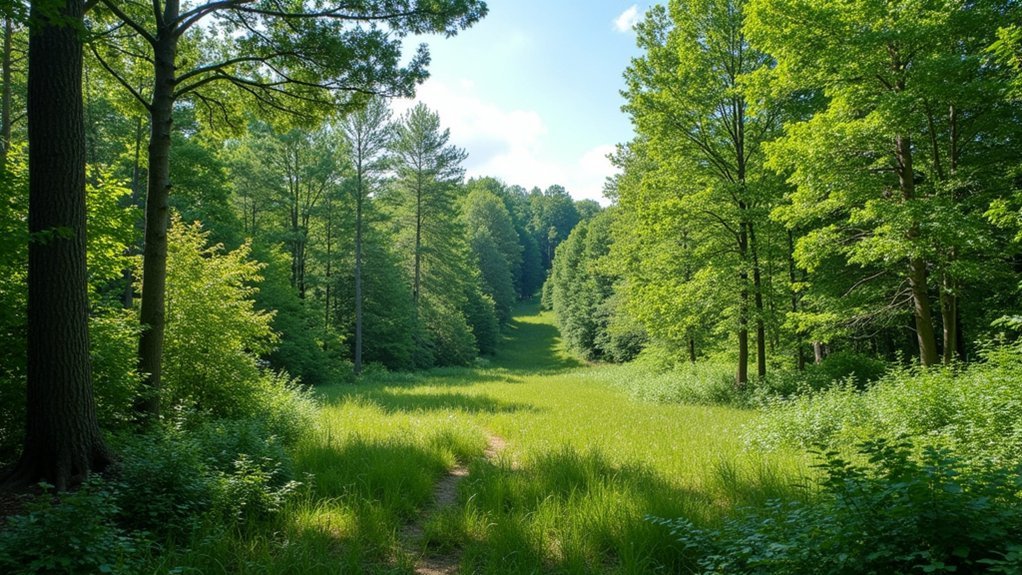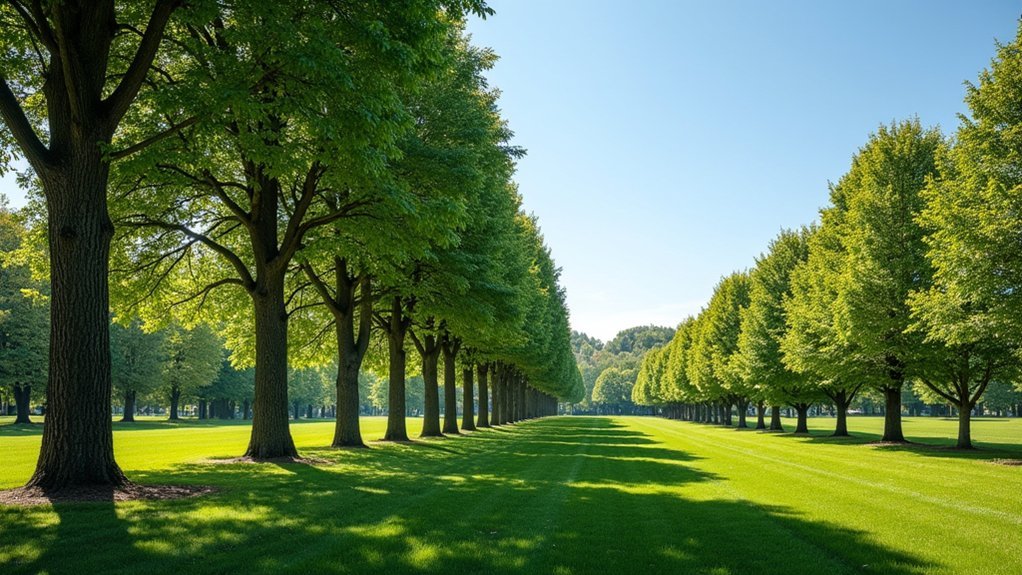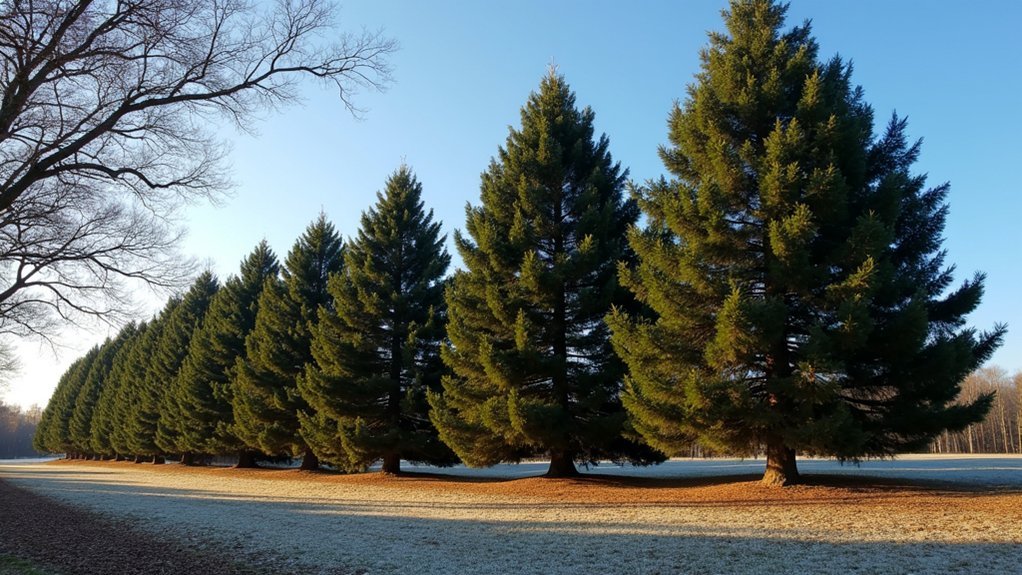For Zone 5 windbreaks, you’ll get excellent year-round protection from Eastern White Pine, Norway Spruce, and Colorado Spruce. Leyland Cypress offers impressive growth of 3-5 feet annually. Add deciduous options like Silver Maple and Red Maple for multi-layer protection. Native choices such as Eastern Red Cedar and Black Oak thrive in various soil conditions. Space smaller trees 10-15 feet apart and larger species 12-20 feet apart. The right combination will transform your property’s microclimate.
Evergreen Conifers for Year-Round Wind Protection

When planning a windbreak in Zone 5, evergreen conifers stand as your most reliable allies against harsh winds throughout all seasons.
Eastern White Pine and Norway Spruce offer exceptional protection with their dense foliage and impressive heights, creating effective barriers against winter gusts.
Towering sentinels with needle-rich branches, these classic evergreens stand firm against winter’s fiercest assaults.
For challenging clay soils, Eastern red cedar proves invaluable, combining fast-growing characteristics with remarkable adaptability to varying conditions.
Colorado spruce brings additional benefits with its striking blue-green color, cold hardiness, and excellent drought tolerance.
If you’re seeking rapid results, consider Leyland Cypress, which grows an impressive 3-5 feet annually and can reach heights of 60-70 feet.
For ideal windbreak effectiveness, combine multiple evergreen trees like White spruce with faster-growing varieties to create a diverse, resilient barrier that supports local wildlife while providing year-round wind protection.
Deciduous Trees for Multi-Layer Windbreak Design
Although evergreens form the backbone of most windbreaks, deciduous trees play an essential role in creating a thorough, multi-layered wind barrier in Zone 5 landscapes.
When designing your windbreak, consider fast-growing options like silver and red maple, which provide dense foliage that effectively reduces winter wind speeds.
For maximum wind protection, arrange deciduous trees in staggered patterns with taller species at the back and shorter varieties in front.
Black walnut and American hazelnut not only contribute to your windbreak’s effectiveness but also benefit wildlife with their nuts and fruits.
Incorporate native trees that match your specific soil types to guarantee long-term success.
Pairing deciduous trees with shrubs like viburnum enhances structural diversity in your multi-layer windbreak, creating a more effective system that protects against strong gusts while supporting local fauna.
Native Zone 5 Species for Sustainable Windbreaks

Native Zone 5 species form the foundation of sustainable windbreaks, offering both environmental benefits and superior climate adaptation.
Eastern Red Cedar grows 1-2 feet annually, reaching 40-50 feet while providing excellent wind protection and wildlife habitat. For fast-growing options, consider Red Maple, which reaches 40-60 feet with stunning fall color.
When planning rows of trees, incorporate Black Oak for its resilience in various soil types and impressive 60-80 foot mature height.
For diversity, add Serviceberry shrubs between taller trees—they’ll produce edible berries while attracting pollinators.
While white pines are popular, Sugar Maple offers similar windbreak protection with additional ecological benefits.
Fast-Growing Options for Immediate Wind Barrier Results
For gardeners seeking quicker shelter from punishing winds, fast-growing trees offer compelling advantages alongside native selections.
You’ll appreciate the Dawn Redwood’s impressive growth rate of 13-24 inches annually, reaching 25 feet to create effective wind protection within a few seasons.
White Pine and Norway Spruce are exceptional choices, both growing up to 3 feet yearly.
While White Pine can tower 50-80 feet, Norway Spruce typically reaches 40-60 feet, providing shelter for wildlife too.
For truly rapid results, consider Leyland Cypress, which adds 3-5 feet annually, maturing to 60-70 feet.
If you need a more compact windbreak, Emerald Green Arborvitae grows at similar speeds but tops out at just 12-14 feet, offering versatility for smaller properties while still delivering effective wind protection.
Spacing and Arrangement Strategies for Maximum Effectiveness

Creating an effective windbreak requires strategic spacing and thoughtful arrangement of your selected trees and shrubs. For maximum effectiveness, consider both in-row and between-row spacing based on plant type.
| Plant Type | In-Row Spacing | Between-Row Spacing |
|---|---|---|
| Deciduous Shrubs | 3-6 feet | 6-10 feet |
| Small Trees | 10-15 feet | 20 feet |
| Deciduous Trees | 12-20 feet | 20 feet |
Arrange your windbreak to achieve 25-50% density for crop protection or 50-65% for snow management. Stagger your conifer trees in multiple rows to enhance wind-blocking capability while maintaining visual appeal. For a basic effective windbreak, combine one row of deciduous shrubs with two rows of trees. You’ll need to adjust your spacing based on local conditions and guarantee that trees complement each other’s height and growth rates.
Frequently Asked Questions
What Is the Fastest Growing Tree for Windbreak?
The Leyland Cypress is your fastest windbreak option. You’ll see impressive growth of 3-5 feet annually, and it’ll reach heights of 60-70 feet at maturity. Thuja ‘Green Giant’ grows equally fast.
What Trees Are Good for Breaking Wind?
For breaking wind, you’ll find that Norway spruce, Eastern red cedar, and Colorado blue spruce work excellently. Don’t overlook fast-growing options like Leyland cypress and Thuja ‘Green Giant’ that provide quick protection.
What Is the Strongest Trees Against Wind?
For strongest trees against wind, you’ll find Norway Spruce and Eastern Red Cedar exceptional. They’re built with sturdy structures that withstand high winds, while Leyland Cypress provides rapid growth with good resistance too.
What Are the Fastest Growing Trees in Zone 5?
In Zone 5, you’ll find Leyland Cypress growing 3-5 feet yearly is fastest. Dawn Redwood reaches 13-24 inches annually, while Giant Green Arborvitae and Norway Spruce both achieve impressive 3-foot yearly growth rates.
In Summary
You’ll get the best windbreak results by combining evergreens like spruce and pine with deciduous trees like oak and maple in staggered rows. Choose native species when possible for better survival rates and ecosystem benefits. Don’t forget to space trees properly based on mature size. With fast-growing options like hybrid poplar alongside long-lived species, you’ll create a windbreak that offers protection for generations.





Leave a Reply